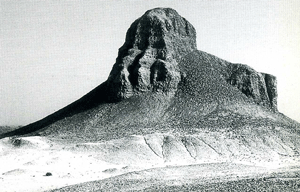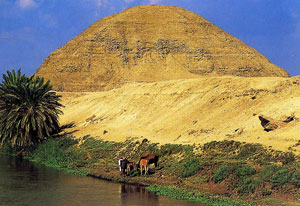

Burial chamber in the pyramid of Unas

Later Pyramids
After the Giza pyramids, the Egyptians continued building royal pyramids for nearly a thousand years. None of these were made as big as the Giza pyramids, or in the same way, with horizontal rows of large, well-cut stone blocks.
Many of these later pyramids have collapsed into big piles of rubble or mud brick, and are not much to look at. In some cases, pyramids were begun but never finished, perhaps because the pharaoh died young.
Still, many of these pyramids have interesting features, such as walls carved all over and painted with hieroglyphs, and beautiful treasures found in the nearby tombs of princesses. On this page we will take a look at some of these later pyramids.

The Pyramid of Userkaf at Saqqara
Userkaf
The first king of the 5th dynasty was Userkaf, who ruled not long after Menkaure. He decided to build his pyramid at Saqqara, like Djoser. It was originally 49m high and 73m wide.
It is now a big pile of loose stones (see photo above). At first it was cased in a smooth layer of fine limestone, like the Giza pyramids. This was robbed, however, as it was with nearly all the pyramids. Underneath, the stones were laid so haphazardly that the structure was not strong, and it slumped into a pile.
It may be that these poorer stones were cut small because of the different rock at Saqqara. Here, the limestone is found only in thin layers - so it is not possible to cut out large, strong blocks, like at Giza.
Unas
At the end of the 5th dynasty a pharaoh called Unas built his pyramid at Saqqara. He ruled for over 30 years, but his pyramid was the smallest of the Old Kingdom pyramids. As the photo below shows, it is not in good condition.

The Pyramid of Unas at Saqqara (the Step Pyramid is
in the background)
Unas's pyramid was 43m high and 58m wide. Although not much to look at on the outside, the inside is quite special. The walls under the Step Pyramid were decorated with carvings, hieroglyphs and blue tiles. Since then however no pharaoh had decorated their pyramid. Unas changed all that.
The burial chamber (see photo top right of this page) was brightly carved and painted to represent a reed-mat and wood-frame enclosure, and with golden stars on a blue ceiling. This meant that in his coffin, Unas lay inside a holy reed-booth open to the sky.
As well as this, the chambers are covered with very finely carved hieroglyphs in columns, painted blue. This is the first example of the famous Pyramid Texts.
The Pyramid Texts are magic spells intended to guide and protect the pharaoh on his travels to and from the afterlife. Unas's pyramid contains 283 of these spells.
Teti
Teti was the next pharaoh after Unas and the first of the 6th dynasty. He lived around 2300BC and built his pyramid at Saqqara in a similar way to Unas. Like Unas's pyramid it has collapsed into a rounded mound.

Teti's burial chamber and sarcophagus
Inside, a passage slopes down to rooms in much the same way as in Unas's pyramid, with the Pyramid Texts inscribed on the walls.

THe Pyramid Texts in Teti's pyramid. Teti's name is in the cartouche - two 't's and an 'i'.

Gold crown belonging to Sithathoriunet, daughter of Senusret II
Pepi I, Merenre and Pepi II
The pharaohs of the rest of the 6th dynasty built their pyramids in a similar way to Unas and Teti. They are all in poor condition, and have chambers with the Pyramid Texts.
Pepi II was the last strong pharaoh of the Old Kingdom. He is famous for having ruled for an amazing 94 years, from the age of 4 to 98. His pyramid was built in five steps of limestone blocks, covered in walls made of clay and mud, and finally cased in fine limestone without mortar.

Pyramid of Pepi II. It was 52m high and 78m wide.
Middle Kingdom Pyramids: Amenemhat I
After the Old Kingdom there was a period of disorder and weak rule in Egypt, lasting about a hundred years. Eventually the pharaoh took control over the whole country and what we call the Middle Kingdom began.
The first pharaoh of the 12th dynasty was Amenemhat I, who ruled from about 1990-1960BC. His pyramid was built at el-Lisht, halfway between Meidum and Dashur (south of Saqqara).
Pyramid of Amenemhat I
The core of the pyramid was made of rough blocks of limestone, with a loose fill of sand, dirt and mudbrick. It was 55m high and 84m wide. As the photo above shows, it is now a pile of rubble. Amenemhat had his workers steal blocks from the Giza pyramids to build the passages in his own pyramid.
Amenemhat's son Senusret I also built his pyramid at el-Lisht. After this, from Amenemhat II onwards, all pyramids built between Dahshur and the Faiyum (a marshy area to the west of the Nile - see map).
Senusret II
Senusret II was the fourth pharaoh of the 12 dynasty and his pyramid was built in the Faiyum area, near the modern town of el-Lahun. As the photo shows, it has now collapsed, but it is interesting for two reasons.

About 1km away, near the valley temple, a city was discovered, now known as Kahun. This is very important, because very few cities are known in Egypt. A lot of objects have been found in Kahun, telling us a great deal about ordinary life in ancient Egypt. Many are on show in the Manchester Museum and the Petrie Museum in London.
Map of the ancient pyramid town of Senusret. Now known as Kahun, its ancient name was Hetep Senusret, 'May Senusret be at peace'. You can see streets, small houses, and larger houses of more important people, as well as a strong surrounding wall.
Treasure
A beautiful collection of jewellery was found in the area of Senusret II's pyramid, especially in the tomb of his daughter Sithathoriunet (see below and left).

A sacred cobra, or uraeus, found in the pyramid. It was worn on the pharaoh's crown.

Mirror of Sithathoriunet, made of silver, gold and obsidian, and with the face of Hathor, goddess of beauty
Amenemhat III
Amenemhat was the grandson of Senusret II. He ruled for 46 years and built two pyramids, one at Dahshur and one at Hawara, in the Faiyum.
Both pyramids were built with a core of large mudbricks and cased with limestone. Not surprisingly, after the limestone was robbed, the mudbricks collapsed.
For a later pyramid, the first one at Dahshur was large - 75m high and 105m wide. Its name was 'Amenemhat is Beautiful'.

Amenemhat III's pyramid at Dahshur
The second pyramid at Hawara was originally 58m high and 105m wide. Its name was 'Amenemhat Lives'.
The pyramid of Amenemhat III at Hawara
The Treasure of Princess Neferuptah
Beautiful treasures were found 2km from the Hawara pyramid, in the tomb of Neferuptah, one of the daughters of Amenemhat III. The best of these treasures is a collar of more than 1000 beads, made from gold, carnelian and amazonite. It has two gold falcon heads and a counterweight to balance the collar on the neck.
Matching the collar were a set of bracelets for wrists and ankles, made of the same materials as the collar.

The Pyramids of Nubia
About 800 years after the last royal pyramid was built in Egypt, a new kingdom arose in the land of Nubia to the south, or Kush as it was then known. Kush ruled over southern Egypt for a while, and the kings were buried in Egyptian-style pyramids.
These pyramids were smaller than the Egyptian pyramids, but about 180 were built, which is twice as many as in Egypt. The tallest of them was no more than 50m high, built for the pharaoh Taharqa. The sides were very steep, and they were built packed together.
Pyramids at Meroe, dated from around 300BC to AD350
The most famous Nubian pyramids are at three areas, el-Kurru, Nuri, and Meroe. When the civilization of Meroe finally fell apart about AD350, it was the end of pyramids as royal tombs forever.

Map of the pyramids at Meroe
The Meroe pyramids had entrances modelled after the great pylons of Egyptian temples.






